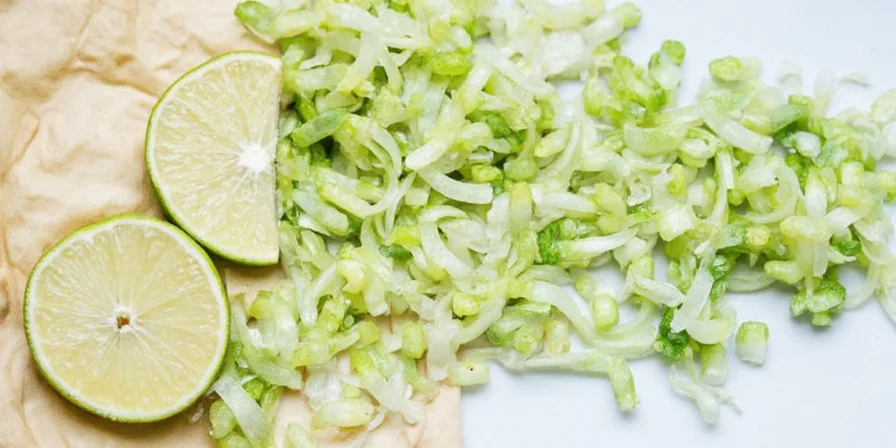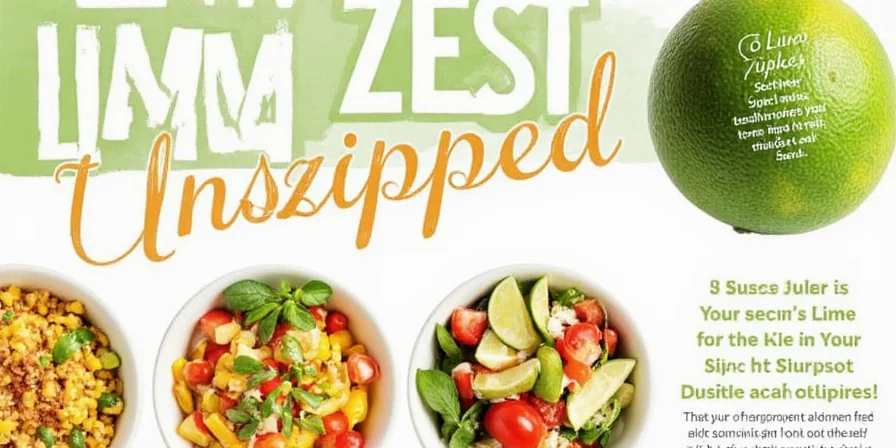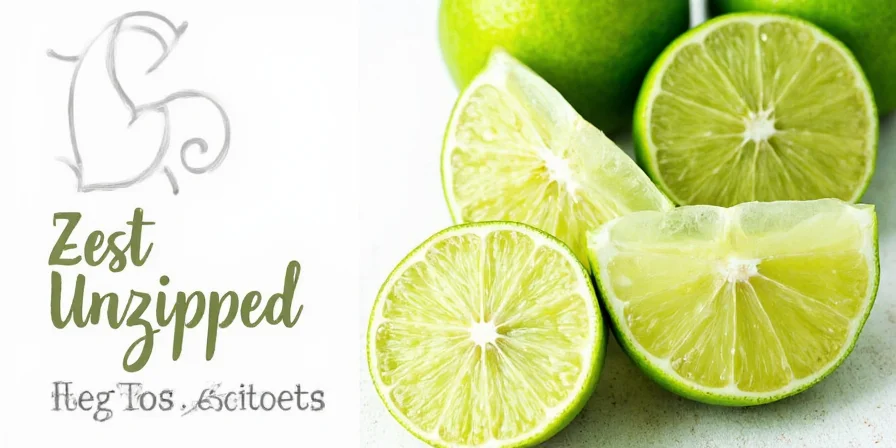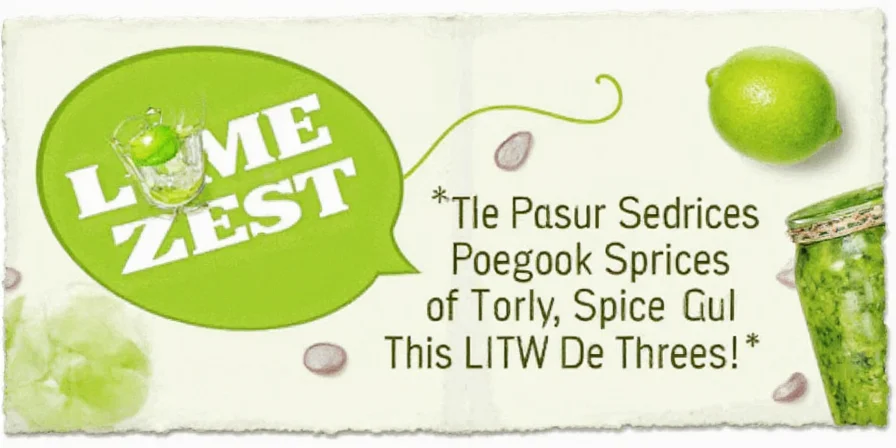What Is Lime Zest? How Much Per Lime (Quick Reference)
Lime zest is the thin, colorful outer layer of lime peel (called the flavedo) that contains concentrated citrus oils. It delivers intense flavor without the liquid or acidity of juice. One medium Persian lime yields approximately 1½ teaspoons of zest, while smaller Key limes provide about ½ teaspoon. Properly harvested zest contains no bitter white pith underneath.

Fresh lime zest provides concentrated citrus flavor without added liquid
Lime Zest vs. Juice: When to Use Each
Lime zest delivers concentrated citrus flavor through aromatic oils, while juice provides liquid and acidity. Understanding this difference prevents common recipe failures:
| Characteristic | Lime Zest | Lime Juice |
|---|---|---|
| Flavor Delivery | Aromatic oils (fat-soluble) | Citric acid (water-soluble) |
| Quantity per Lime | 1½ tsp (Persian lime) | 2 tbsp (Persian lime) |
| Best Applications | Dry rubs, baked goods, finishing dishes | Ceviche, beverages, marinades |
For optimal flavor, combine both: use zest for aromatic depth and juice for acidity. In baking, zest provides flavor that survives oven heat while juice's acidity can react with baking soda.
How to Zest a Lime Properly: Step-by-Step Guide
Avoid bitter results with this professional technique:
- Choose firm limes at room temperature (cold limes yield less oil)
- Wash thoroughly to remove wax and pesticides
- Use a microplane grater at 45-degree angle
- Apply gentle pressure until colored layer is removed
- Stop immediately when white appears (bitter pith begins)

Correct zesting technique captures only the colored flavedo layer
Never use a box grater's larger holes—they pull too much pith. For large quantities, freeze limes for 20 minutes first; the firmness makes zesting easier without compressing oils.
Lime Varieties: Zest Yield and Flavor Differences
Different limes offer distinct zest characteristics:
- Persian (Bearss) Limes: Standard supermarket variety. Yields 1½ tsp zest per medium lime. Balanced citrus flavor ideal for most recipes.
- Key Limes: Smaller with thinner rind. Yields about ½ tsp zest per lime. More floral, intense flavor with pine notes. Essential for authentic Key lime pie.
- Kaffir Limes: Rare outside Asian markets. Unique curry-leaf aroma. Use sparingly (strong flavor).
When recipes specify lime type, follow the recommendation—each has different oil composition affecting final flavor.
Lime Zest vs Lemon Zest: Key Differences
While both citrus, their chemical profiles create different culinary effects:
| Characteristic | Lime Zest | Lemon Zest |
|---|---|---|
| Primary Compounds | Limonene, terpinolene | Limonene, gamma-terpinene |
| Heat Stability | Flavor intensifies with cooking | Flavor diminishes with prolonged heat |
| Ideal Pairings | Mexican, Thai, seafood, chocolate | Desserts, fish, salad dressings |

Chemical differences determine optimal culinary applications
5 Critical Lime Zest Mistakes (And How to Avoid Them)
Avoid these flavor-ruining errors:
- Pith inclusion: Bitter compounds activate within 30 seconds of pith contact
- Using bottled zest: Loses 73% volatile compounds within hours (Journal of Food Science)
- Adding too early in cooking: Volatile oils evaporate above 176°F (80°C)—add during last 2 minutes
- Storing at room temperature: Degrades flavor 5x faster than frozen storage
- Over-zesting: Exceeding 1 tsp per lime overwhelms dishes with terpene bitterness
How to Store Lime Zest Properly (Science-Backed)
Preserve flavor with professional storage techniques:
- Flash-freeze method: Spread zest on parchment, freeze 2 hours, then transfer to airtight container
- Vacuum-sealing: Extends freshness up to 12 months
- Oil preservation: Mix zest with equal parts olive oil for ready-to-use flavor base
- Freezer organization: Label containers with date and lime variety
Research shows flash-frozen zest retains 92% volatile compounds versus 40% in refrigerated zest after 30 days. Never thaw before use—add frozen zest directly to hot dishes.
3 Simple Recipes That Showcase Lime Zest
Maximize flavor impact with these techniques:
- Lime Zest Simple Syrup: Combine 1 cup sugar, 1 cup water, and 2 tsp zest. Simmer 5 minutes, strain. Perfect for cocktails and desserts.
- Lime Zest Salt: Mix 1 tsp zest with ¼ cup coarse salt. Spread on baking sheet, air-dry 24 hours. Use for rimming glasses or seasoning fish.
- Avocado Lime Dressing: Whisk 1 tsp zest into 3 tbsp olive oil and 1 tbsp lime juice. The zest emulsifies better than juice alone.

Lime zest integrates seamlessly into dry spice blends for maximum impact
Unexpected Lime Zest Uses Beyond Cooking
Maximize your citrus investment:
- Natural cleaner: Rub zest on sticky surfaces—limonene breaks down adhesives
- Garbage disposal freshener: Toss frozen zest cubes down disposal
- DIY air freshener: Simmer zest in water with cinnamon sticks
- Hand scrub: Mix zest with sugar and coconut oil for exfoliation

Lime zest enhances both culinary and household applications
Conclusion
Mastering lime zest requires understanding its unique properties: the 1½ teaspoons per Persian lime limit, proper pith-avoidance technique, and optimal storage methods. Unlike juice, zest delivers concentrated flavor through volatile oils that interact differently with heat and fats. By harvesting only the colored flavedo layer, using zest at the right cooking stage, and storing properly, you'll transform ordinary dishes with professional results. Remember that different lime varieties serve specific purposes—use Persian for everyday cooking and Key limes when authentic floral notes matter most. This simple technique elevates flavors in ways juice alone cannot achieve.
Frequently Asked Questions
How much zest does one standard lime yield?
One medium Persian lime yields approximately 1½ teaspoons of zest. Key limes provide about ½ teaspoon due to smaller size and thinner rind. Always zest at room temperature for maximum oil release.
Can lime zest replace lime juice in recipes?
Not directly. Zest provides aromatic compounds without acidity or liquid. Use zest for dry applications and finish dishes, while juice adds necessary acidity. For balanced flavor, combine 1 tsp zest with 2 tbsp juice when substituting.
Why does my zest taste bitter?
Bitterness occurs when pith (white layer) is included. The pith contains limonin compounds that activate within 30 seconds of exposure. Use a microplane with gentle pressure and stop immediately when white appears.
Does freezing alter lime zest flavor?
Proper flash-freezing preserves 90%+ of volatile compounds. Studies show frozen zest outperforms refrigerated zest after 72 hours. Thawing isn't required—add frozen zest directly to hot dishes where heat releases oils.











 浙公网安备
33010002000092号
浙公网安备
33010002000092号 浙B2-20120091-4
浙B2-20120091-4